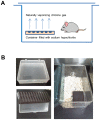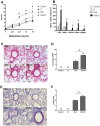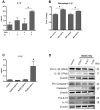Chronic low dose chlorine exposure aggravates allergic inflammation and airway hyperresponsiveness and activates inflammasome pathway
- PMID: 25202911
- PMCID: PMC4159271
- DOI: 10.1371/journal.pone.0106861
Chronic low dose chlorine exposure aggravates allergic inflammation and airway hyperresponsiveness and activates inflammasome pathway
Abstract
Background: Epidemiologic clinical studies suggested that chronic exposure to chlorine products is associated with development of asthma and aggravation of asthmatic symptoms. However, its underlying mechanism was not clearly understood. Studies were undertaken to define the effects and mechanisms of chronic low-dose chlorine exposure in the pathogenesis of airway inflammation and airway hyperresponsiveness (AHR).
Methods: Six week-old female BALB/c mice were sensitized and challenged with OVA in the presence and absence of chronic low dose chlorine exposure of naturally vaporized gas of 5% sodium hypochlorite solution. Airway inflammation and AHR were evaluated by bronchoalveolar lavage (BAL) cell recovery and non-invasive phlethysmography, respectively. Real-time qPCR, Western blot assay, and ELISA were used to evaluate the mRNA and protein expressions of cytokines and other inflammatory mediators. Human A549 and murine epithelial (A549 and MLE12) and macrophage (AMJ2-C11) cells were used to define the responses to low dose chlorine exposure in vitro.
Results: Chronic low dose chlorine exposure significantly augmented airway inflammation and AHR in OVA-sensitized and challenged mice. The expression of Th2 cytokines IL-4 and IL-5 and proinflammatory cytokine IL-1β and IL-33 were significantly increased in OVA/Cl group compared with OVA group. The chlorine exposure also activates the major molecules associated with inflammasome pathway in the macrophages with increased expression of epithelial alarmins IL-33 and TSLP in vitro.
Conclusion: Chronic low dose exposure of chlorine aggravates allergic Th2 inflammation and AHR potentially through activation of inflammasome danger signaling pathways.
Conflict of interest statement
Figures





Similar articles
-
Aggravation of asthmatic inflammation by chlorine exposure via innate lymphoid cells and CD11cintermediate macrophages.Allergy. 2020 Feb;75(2):381-391. doi: 10.1111/all.14017. Epub 2019 Sep 9. Allergy. 2020. PMID: 31402462
-
Adjuvant-dependent regulation of interleukin-17 expressing γδ T cells and inhibition of Th2 responses in allergic airways disease.Respir Res. 2014 Aug 14;15(1):90. doi: 10.1186/s12931-014-0090-5. Respir Res. 2014. PMID: 25123451 Free PMC article.
-
Experimental protocol for development of adjuvant-free murine chronic model of allergic asthma.J Immunol Methods. 2019 May;468:10-19. doi: 10.1016/j.jim.2019.03.002. Epub 2019 Mar 14. J Immunol Methods. 2019. PMID: 30880263
-
Epithelial-Derived Cytokines in Asthma.Chest. 2017 Jun;151(6):1338-1344. doi: 10.1016/j.chest.2016.10.042. Epub 2016 Nov 3. Chest. 2017. PMID: 27818325 Review.
-
Biologics and the lung: TSLP and other epithelial cell-derived cytokines in asthma.Pharmacol Ther. 2017 Jan;169:104-112. doi: 10.1016/j.pharmthera.2016.06.009. Epub 2016 Jun 27. Pharmacol Ther. 2017. PMID: 27365223 Review.
Cited by
-
Investigation on the effectiveness of ventilation dilution on mitigating COVID-19 patients' secondary airway damage due to exposure to disinfectants.Build Environ. 2023 Jan 15;228:109787. doi: 10.1016/j.buildenv.2022.109787. Epub 2022 Nov 12. Build Environ. 2023. PMID: 36407877 Free PMC article.
-
Anti-oxidant and Anti-inflammatory Effects of Aquatic Exercise in Allergic Airway Inflammation in Mice.Front Physiol. 2019 Sep 24;10:1227. doi: 10.3389/fphys.2019.01227. eCollection 2019. Front Physiol. 2019. PMID: 31611811 Free PMC article.
-
Low dose of chlorine exposure exacerbates nasal and pulmonary allergic inflammation in mice.Sci Rep. 2018 Aug 22;8(1):12636. doi: 10.1038/s41598-018-30851-6. Sci Rep. 2018. PMID: 30135462 Free PMC article.
-
Changes in vitreal protein profile and retina mRNAs in Reeler mice: NGF, IL33 and Müller cell activation.PLoS One. 2019 Feb 27;14(2):e0212732. doi: 10.1371/journal.pone.0212732. eCollection 2019. PLoS One. 2019. PMID: 30811468 Free PMC article.
-
Asthma-inducing potential of 28 substances in spray cleaning products-Assessed by quantitative structure activity relationship (QSAR) testing and literature review.J Appl Toxicol. 2022 Jan;42(1):130-153. doi: 10.1002/jat.4215. Epub 2021 Jul 11. J Appl Toxicol. 2022. PMID: 34247391 Free PMC article. Review.
References
-
- Holgate ST (2008) Pathogenesis of asthma. Clin Exp Allergy 38: 872–897. - PubMed
-
- Bernard A (2007) Chlorination products: emerging links with allergic diseases. Current medicinal chemistry 14: 1771–1782. - PubMed
-
- Brooks SM, Weiss MA, Bernstein IL (1985) Reactive airways dysfunction syndrome (RADS). Persistent asthma syndrome after high level irritant exposures. Chest 88: 376–384. - PubMed
-
- Das R (1993) Blanc PD (1993) Chlorine gas exposure and the lung: a review. Toxicology and industrial health 9: 439–455. - PubMed
-
- Evans RB (2005) Chlorine: state of the art. Lung 183: 151–167. - PubMed
Publication types
MeSH terms
Substances
LinkOut - more resources
Full Text Sources
Other Literature Sources
Medical

